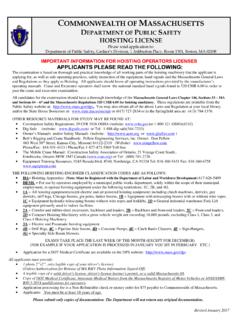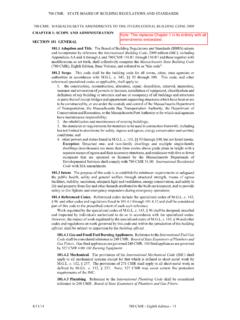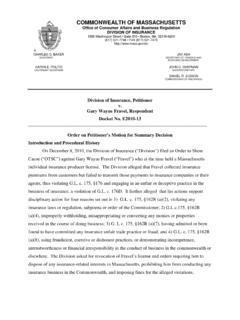Transcription of Apprenticeship: It Makes Good Business Sense - Mass.Gov
1 1 apprenticeship : It Makes good Business Sense How can Registered apprenticeship work for you? By registering your apprentice training program with the Division of Apprentice Standards your company will gain access to: Assistance in developing a work process that is aligned with a curriculum that result in training which provides a portable credential at its completion. This credential is consistent with industry standards and recognized throughout the industry allowing companies to remain competitive. Quality training programs often improve corporate Standard and Poor ratings. Assistance in locating qualified applicants through Career Centers and Vocational Schools. Here is a toolkit to help you organize a Registered apprenticeship Program: The Massachusetts Department of Labor Standards, Division of apprenticeship Standards, and the Massachusetts apprenticeship Advisory Council is pleased to provide you with this employer toolkit.
2 It is designed to give you what you need to know about apprenticeship what it is and how it benefits your Business . You will learn how apprenticeship works and how it can affect your bottom line. Tools and resources are available to get your company started training apprentices. This toolkit was designed to answer some of the most common questions about apprenticeship . Message from the Massachusetts apprenticeship Advisory Council ..2 What is apprenticeship ? ..3 Benefits of training apprentices ..5 Tips for implementing a successful Valuable information effective mentoring techniques ..7 Simple steps for starting a successful apprenticeship program in your Roles and responsibilities ..12 apprenticeship Office Contacts ..13 2 A message from the Massachusetts apprenticeship Advisory Council If you own or manage a Business , you make investment decisions every day. Some of the major decisions you make include: investing in space (office space, warehouse space, shop space, production space, work space, or retail space), investing in material, raw materials, product, or supplies, and investing in your equipment.
3 These are all tangible investments. They can all be touched, felt, and seen. There is another kind of investment that companies make . It is called the human investment. Successful companies realize that their employees are one of their most valuable assets. Your workforce has to be a positive reflection of your company. Organizations that train tend to thrive, even in the face of strong competition. If your Business and the Massachusetts economy are going to grow, it is important to develop a skilled workforce. The Massachusetts apprenticeship program is a resource you can use to ensure that your company operates at peak efficiency. apprenticeship is a time-honored training system that involves a combination of classroom and on-the-job training under the direction of a skilled worker. Training apprentices is the best way to guarantee that your employees are trained in industry-accepted practices as well as in specific techniques and methods employed by your company.
4 To assist you in making a decision to invest in your workforce, here are three reasons that companies train apprentices: Productivity What if everyone in your company was either in apprenticeship training or had completed an apprenticeship ? It is a simple fact that a person who is properly trained is far more productive than someone who has not been trained. Classroom Instruction + On the Job Training = Increased Productivity. Retention There have been a number of studies that have shown that employees who are properly trained tend to stay working for the same employer longer. In addition, they use fewer sick days. One of the reasons is the difference between working in a job and having a career. In general, those who are in careers tend to stay with their employers. Quality The apprenticeship training process instills a Sense of pride. The training environment in both the classroom and in the field dictates that it is simply not acceptable to slap things together.
5 This learned attitude increases the overall standard of quality. Companies that offer apprenticeship training opportunities often attract higher quality job applicants. The person who wants to serve an apprenticeship is one who is willing to make a commitment to their career and to your company. It all comes down to a willingness to invest in your most valuable resource your employees. Training apprentices is one of the best ways to accomplish this investment. If you empower your employees through training, you will see direct benefits. Take the first step and find out more about how you can make the apprenticeship training process work for you 3 What is apprenticeship ? The apprenticeship method of training of a skilled worker passing on craft knowledge to others, is almost as old as recorded history. Since the middle ages, skills have been passed on through a master-apprentice system in which the apprentice was indentured (contracted) to the master for a specified period of years.
6 The apprentice usually received food, shelter, and clothing in return for the work the apprentice performed while under the apprentice indenture (contract). The indenture was a legally binding document, but there was no oversight or regulation of the indenture. apprenticeship in the continued as an unregulated system until 1937, when the federal government passed the country s first apprenticeship law, The Fitzgerald Act. In 1945, the Massachusetts legislature established the Division of Apprentice Standards, to implement the federal law on the state level. From 1945 to present day, thousands of apprentices have gone through this system and have contributed to the state s economy. Eight Essential Components of apprenticeship Training 1. Structured Training: apprenticeship is a training strategy that: combines supervised, structured on-the job training with related instruction is sponsored by employers, employer associations or labor/management groups that have the ability to hire and train in a working environment.
7 The employment opportunity is the most basic requirement for any apprenticeship . Without the job, there is no on-the-job training. On-the-job training component represents approximately 90% of the program. provides quality related instruction. Related instruction is theoretical and technical, and it is usually provided by an approved training provider or an in-house training center. Related Instruction is a key part of each apprenticeship and it is required by Massachusetts Apprentice Act. This law requires 150 hours of related instruction per year. 2. Skilled Training: apprenticeship is a training strategy that prepares people for skilled employment by conducting training in bona fide and documented employment settings. The content of training, both on-the-job and for related instruction is defined by industry standards. In Massachusetts, we use an apprenticeship Advisory Council model in the development industry standards.
8 The purpose of the Council is to formulate minimum state standards for each trade and to make recommendations to the Division of Apprentice Standards Members of the Apprentice Advisory Council are made up of an equal number of labor and management members representing industries involved in actively training apprentices. 3. apprenticeship Laws: apprenticeship is a training strategy with requirements that are clearly stated in Federal and State laws and regulations. The National apprenticeship Act of 1937 (also known as the Fitzgerald Act) provides the guidance from the federal level. The Massachusetts Apprentice Statutes and Regulations provide additional state requirements. These laws and regulations establish minimum requirements for protecting the welfare of the apprentice, such as: 4 a. the length of training, b. type and amount of related instruction c. supervision of the apprentice d. appropriate ratios of apprentices to journey workers e.
9 Apprentice selection and recruitment procedures, etc. 4. Credentials: apprenticeship is a training strategy that by virtue of a legal contract leads to a certificate of completion and official/recognized journey worker status. The contracts and completion certificates are issued by the Division of apprenticeship Standards. These credentials have explicit meaning, recognition, and respect in the eyes of federal and state governments and relevant industries. Also required is the approval and monitoring of the program by the Division of apprenticeship Standards. When employers desire to start or modify an apprentice program, they are provided technical assistance by the Division. 5. Investment in Training: apprenticeship is a training strategy that involves a tangible investment on the part of the apprentice, program sponsor, individual employer or labor/management group. The apprentice s investment is the time to learn skills and to perfect those skills on the job.
10 The apprentice is expected to manage their time, keep their work records, attend classes, and to progress in their apprenticeship program. The apprentice may also be required to pay for tuition or books. The employer s investment includes paying wages while training the apprentice on the job. 6. Earn and Learn: apprenticeship is a training strategy that pays wages to apprentices during the term of their apprenticeship . These wages are a portion of the skilled wage rate that increases throughout the training program in accordance with a predetermined wage scale. The wages must average 50% over the term of the apprenticeship and must not be less than minimum wage. 7. Supervised Training: apprenticeship is a training strategy in which participants learn by working directly under the supervision of skilled workers in the craft, trade or occupational areas. 8. Apprentice Contract: apprenticeship is a training strategy that involves a written agreement, or contract between the apprentice, the employer, and the state.



















